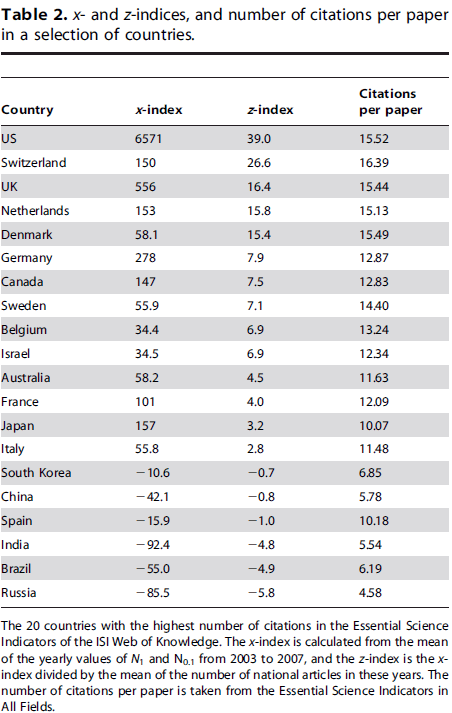|
|
|
|
|
|
|
News & Views item - June 2011 |
![]() Yet Another Index Assessing Citations to Quantify Research Performance in
Nations and Institutions. (June 24, 2011)
Yet Another Index Assessing Citations to Quantify Research Performance in
Nations and Institutions. (June 24, 2011)
 Alonso Rodríguez-Navarro based at the Centro de Biotecnología y Genómica de
Plantas, Universidad Politécnica de Madrid, Madrid, Spain has a 9-page
contribution in the May 2011 issue of PLoS ONE: "A
Simple Index for the High-Citation Tail of Citation Distribution to Quantify
Research Performance in Countries and Institutions" (PLoS ONE 6(5):
e20510. doi:10.1371/journal.pone.0020510).
Alonso Rodríguez-Navarro based at the Centro de Biotecnología y Genómica de
Plantas, Universidad Politécnica de Madrid, Madrid, Spain has a 9-page
contribution in the May 2011 issue of PLoS ONE: "A
Simple Index for the High-Citation Tail of Citation Distribution to Quantify
Research Performance in Countries and Institutions" (PLoS ONE 6(5):
e20510. doi:10.1371/journal.pone.0020510).
In the correspondence section of the June 23, 2011 issue of Nature he refers to a 2011 report by Britain's Royal Society (http://go.nature.com/q8hmxw) which "uses total citation counts as a measure of quality and impact. But citation figures can be misleading, depending on how they are derived. For example, Switzerland and Australia emerge well ahead of Spain when adjustment is made for high-profile, but low-frequency, breakthroughs among the routine results that dominate citation counting, [whereas] the Spanish government announced in March that Spain's scientific research quality has overtaken that of Australia and Switzerland (see http://go.nature.com/si76qc) based on the Royal Society's methodology".
In his PLoS ONE paper Rodríguez-Navarro looks for a correlation between a nation's or institution's highly cited papers, the number of Nobel Laureates it can claim and the number of articles in Nature or Science produced.
After setting out his assumptions and reasoning, Rodríguez-Navarro introduces his x-index (x) which he defines as:
![]()
where N1 and N0.1 are the number of national articles in the top 1%, and 0.1% most cited papers indexed in the ISI Web of Sciences, respectively. Next he defines a z-index noting: "The x-index estimates the total capacity of a research system to produce excellent research, which is higher in larger research systems of similar efficiency. To estimate a normalized research performance I divided the x-index by N [the total number of national articles]. Thus, I defined a size independent z-index as":
![]()
Rodríguez-Navarro's table 2 summarises his calculations for the 20 countries with the highest number of citations in the Essential Science Indicators of the ISI Web of Knowledge.
Perhaps those responsible for foisting the ERA on the universities as a method for distributing public research funding through block grants will find it of interest, But it would be just another inappropriate proxy for directly assessing research proposals based on competent peer review assessments.